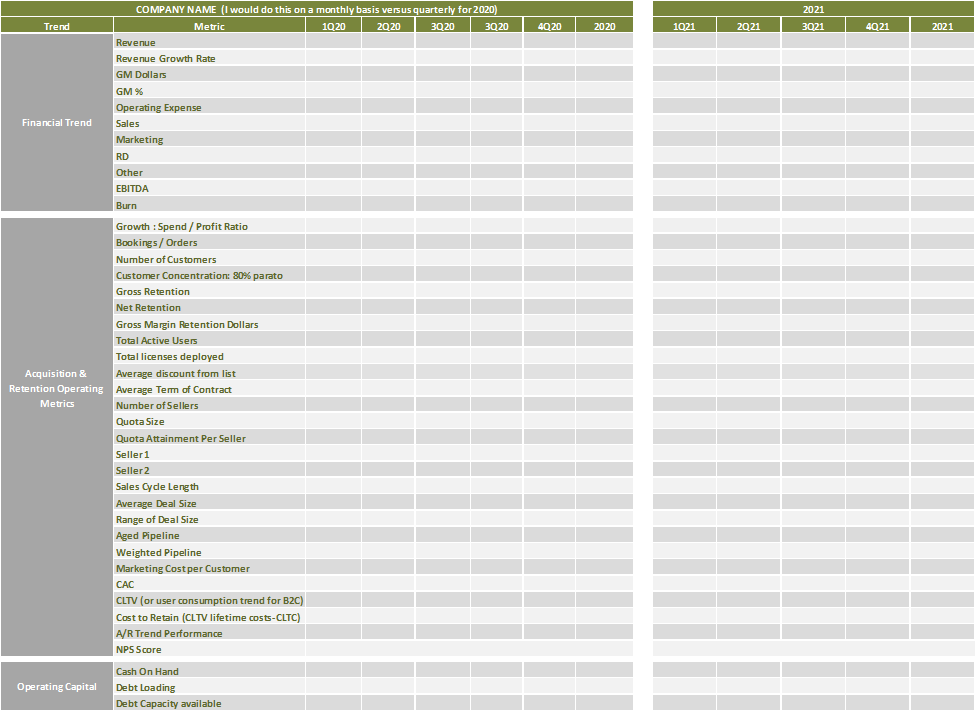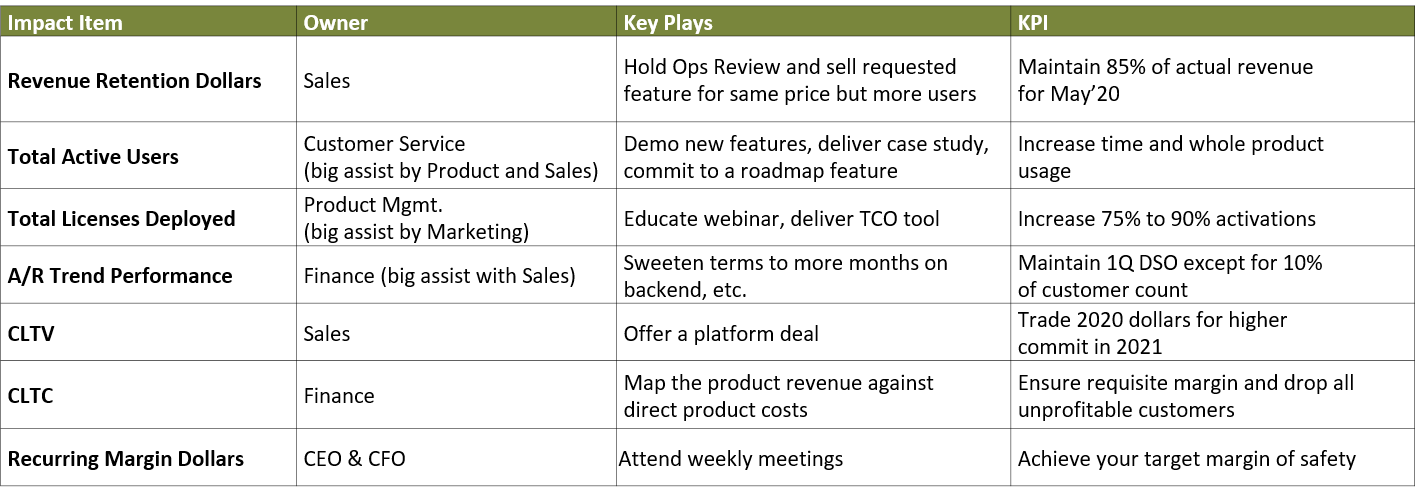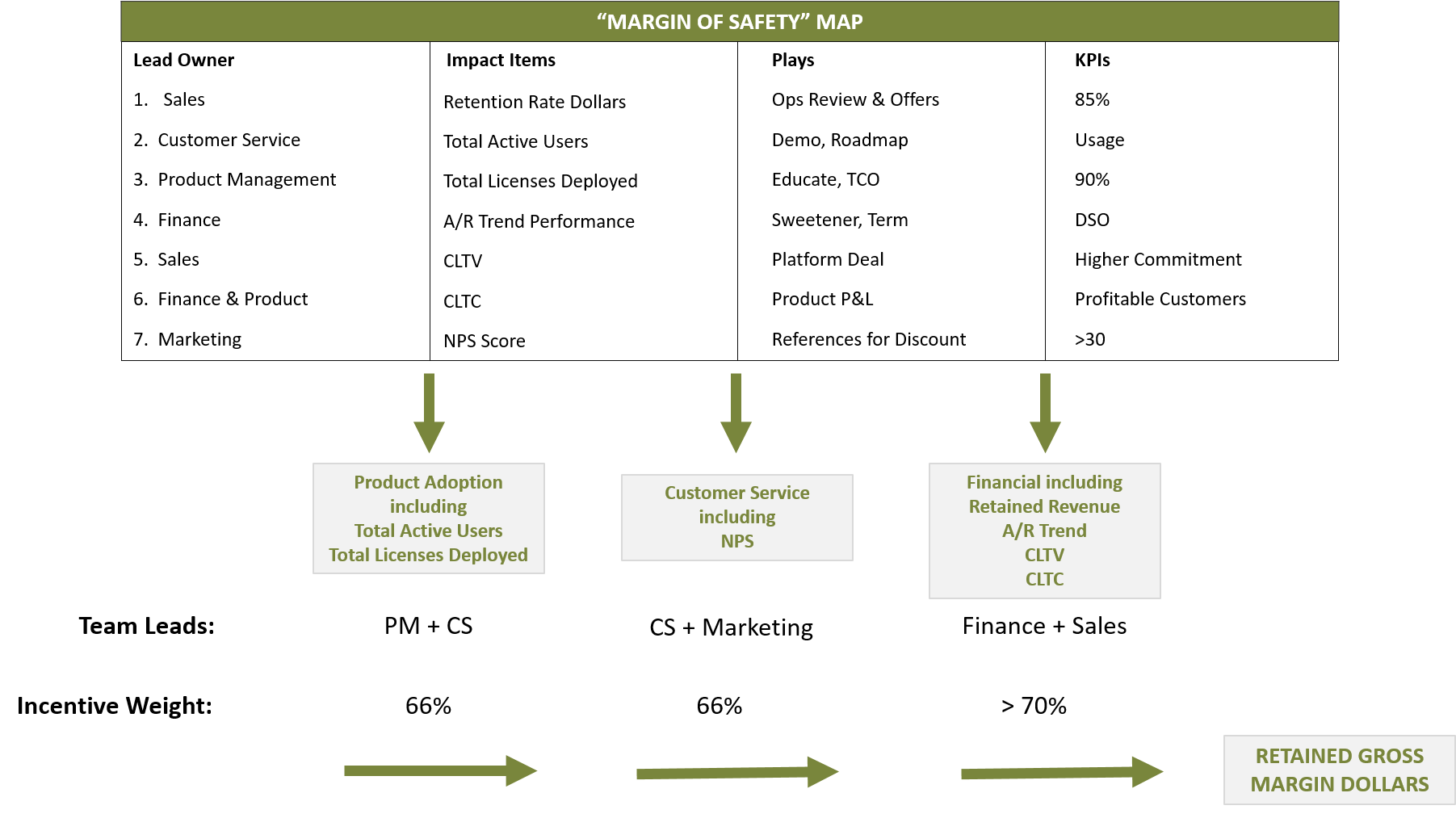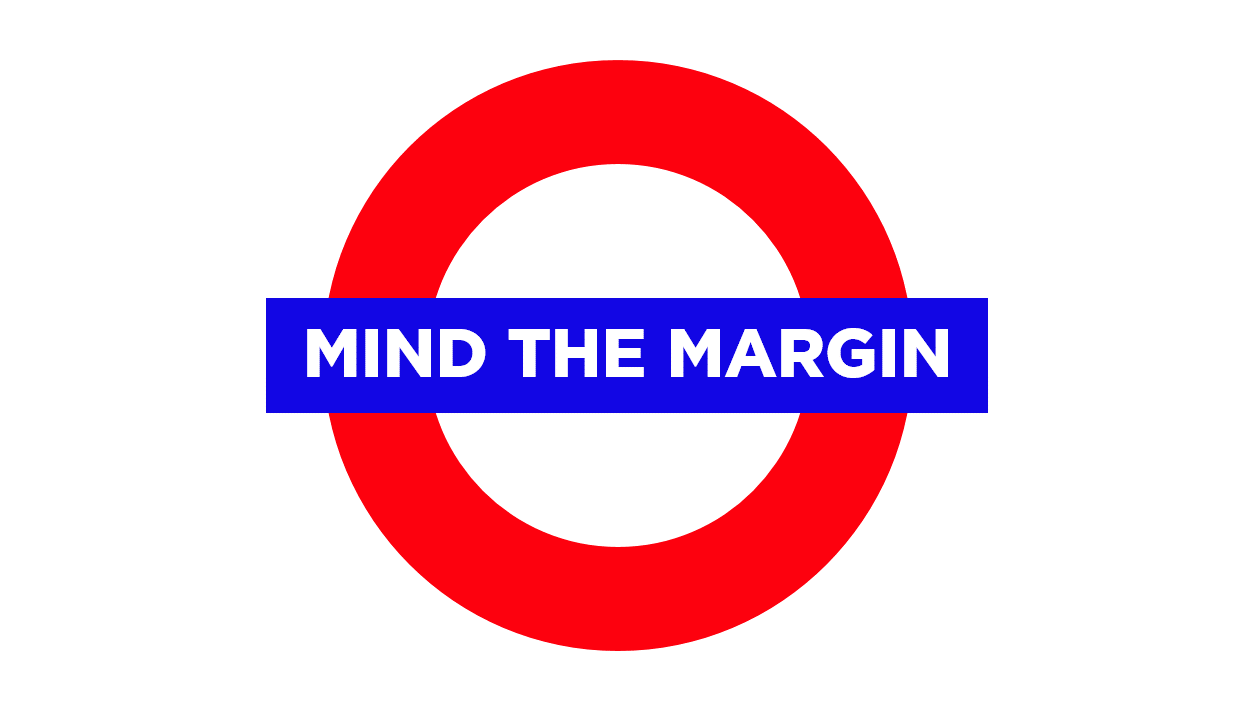The week eight memo that was sent to our CEOs across the country on Sunday, April 26:
Long-term growth strategies for the last ten years have been fun, flexible, and often forgiving. Entrepreneurs enjoyed the trial and error of experimentation, the iterative nature of perfecting a strategy for growth over time.
Now, however, cash runway is the only long-term strategy. Liquidity equals longevity. This strategy requires measuring the major, minor, and minutiae of the business. And measurement is not fun.
CEOs and leaders of private companies face an even bigger challenge: the margin of error for decision-making has narrowed precipitously. Why?
- Dollars are not one for one anymore. Every dollar allocated now is worth far more than the dollar spent eight weeks ago. Every employee’s time this quarter makes far more of a consequential impact than two months ago.
- The margin of error is not time-bound. The swan doesn’t have an expiration date yet. Your margin of error shrinks as the swan impact stretches. Nobody, especially a private, sub $100M company, has infinite resources and capital.
I have a simple solution to ensure better decision-making in this squeezed margin of error era. Do the opposite. Create a margin of safety.
A margin of safety counteracts the margin of error. Here is a formula when making any and all business decisions.
Daily Formula: Margin of Safety > Margin of Error
Three tools under your control today that can combat the margin of error in decision-making and grow your margin of safety:
- Instrumentation. A dashboard, for example, is an instrument that connects you to fact-based insights and action plans. If you do not have a dashboard or some other instrument for decision-making, your margin of error is exponentially higher on Monday morning than that of your competitors.
- An Operational Runbook That Integrates Teams. There are a number of specific projects that build your margin of safety. Some will be recurring and some will be one time. Each will require a set of tactics and talents. You must choose the team and determine the gold metric to measure the progress on the dashboard. All contributors review the same dashboard weekly (daily in some areas) and act through a coordinated organizational process. I call this a runbook, but it might be a playbook, north star project, or a margin of safety plan.
- A System of Shared Rewards. Transparent variable compensation is key to success. Even if compensation amounts are reduced or delayed, all groups need to use shared metrics to measure rewards.
These three tools, in tandem with trust and teamwork, can deliver your best margin of safety multiplier against the narrowing of the margin of error.
Let’s work through an example.
1. Instrumentation:
Every company in the country is focused on retention. Each of us wants to fence and fight our foes to prevent churn and protect the base. This makes sense since we know it is cheaper to keep a customer than acquire a customer. But more importantly, retention extends our margin of safety timeline against the unknown and enhances our liquidity.
I want to anchor our gold metric on retained gross margin dollars versus the classic revenue retention measurement. This is the ultimate margin of safety if bookings significantly decrease. This plus cash will support the entire business. We will use revenue retention as the gateway to get to retained gross margin dollars.
Below is a quarterly measurement table for good or bad times -- but mostly for “normal” times. I am not calling this a dashboard since it is a pattern of data points versus a customized set of KPIs for tracking specific outcomes. I encourage you to have a best practice utilizing some version of this table on a monthly basis during the swan. There are 40 items here, much too many to create a quick, actionable plan for interdependent teams.

Click here to download a copy of this measurement table.
Let’s winnow this measurement table down to the seven measures we need to build an integrated plan tied to retention revenue and ultimately to retained gross margin dollars.
- Retention Rate Dollars
- Total Active Users (assume actual usage is a subset here)
- Total Licenses Deployed (for B2C can be bundle unused)
- A/R Trend Performance
- Customer Lifetime Value (CLTV)
- Customer Lifetime Cost (CLTC – I added this one, but it’s not a classic metric)
- NPS Score

These metrics should be tracked weekly, with product usage and licenses tracked daily. Each metric over time is an input for renewal likelihood. These seven reviewed in combination will produce the most accurate assessment of risks and opportunities to capture the revenue retention and margin dollars.
Please note customer diversification is a major lever to increase your margin of safety. My assumption is you cannot change your installed base, so I do not include it here for the retention objective. You should seek customer diversity moving forward to offset your current margin of error in the installed base.
2. An Integrated Operational Runbook:
While the whole organization is involved in retention, the primary team to lead and execute our retention objective includes five departments: Sales, Marketing, Finance, Customer Service, and Product Management. Each of the seven metrics should be owned by a person from one of those teams. This person will be responsible for driving that metric and ensuring the execution is mapped and integrated to the other six metrics and their respective plays. The runbook is a plan of action across the leaders and contributors of departments that are sequenced and synthesized to produce the retention objective.
This is a snap illustrative example. I assume you have more detailed playbooks with KPIs.

3. Shared Reward System:
There are natural groupings among the seven metrics. Active licenses and total licenses deployed focus on product adoption. NPS is a result of customer satisfaction. Net renewal dollars combine retention rates, A/R, CLTV and CLTC. Therefore, I condensed our seven metrics into three compensation measurements for their variable portion. Too many commission drivers lead to average outcomes. The variable portions should be transparent regarding the weightings.
- Product Adoption
- Customer Satisfaction
- Net Renewal dollars (net of concessions and direct expenses)

While the CRO and sales team might be weighted more heavily on renewal rates and gross margin dollars, product adoption and satisfaction scores are also packaged in the sales team variable commission plan. Note that sales will have the highest variable compensation targets and can be over weighted versus other teams.
Product management may resist their variable compensation being tied to adoption or satisfaction, but they are equally accountable to ensure that the roadmap release decisions were highly impactful to retention gross margins. If not in April, then surely by June. I have even included R&D in retention commissions in the past when we were in a cash jam and we knew that improved onboarding UX would increase license adoption.
Customer satisfaction is the most process-oriented requirement across the teams. The sales, customer service, finance, marketing and product teams must choreograph a daily and weekly unified experience to all customer stakeholders.
Putting it all together:
Below are the three tools consolidated into a final picture to increase your margin of safety based on a revenue retention objective.

This was a quick, rudimentary example to achieve a critical objective utilizing data patterns, process and people wired to only three metrics. You cannot achieve Your Margin of Safety > Margin of Error if you do not have instrumentation, interdependent teams and shared destiny rewards in 2020.
We are here Monday to Sunday.

